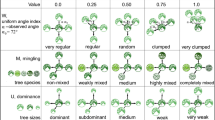Summary
During May and June, 1974, relevés were obtained from 30 plantation stands in the Saginaw Forest in southeastern Michigan. The canopy trees in these plantations were planted between 1904 and 1938. The understory has developed naturally over the years. The forest plantations offer opportunities for study of the effects of the canopy on the structure and species composition of the understory.
A new numerical method of data structuring was used, which is based on the detection patterns of associated species within the table of 30 relevés from Saginaw Forest plantations. The method employs two difference measures. DIF 1 uses presence/absence data and DIF 2 the cover/abundance values obtained from the relevés. Both difference measures supply distance values for every pair of relevés. The least dissimilar relevés are then grouped together by the farthest neighbor agglomerative algorithm of Lance & Williams (1967).
The DIF 1 analysis was inconclusive, but the DIF 2 analysis gave coherent results. It has shown that relevés with similar canopies have similar understories. The differences in understories among the relevés are due less to species composition than to the relative abundances of the species.
Similar content being viewed by others
References
Anderson, R.C., Loucks, O.L., & A.M.Swain. 1969. Herbaceous response to eanopy cover, light intensity, and throughfall precipitation in coniferous forests. Ecology 50: 255–263.
Benninghoff, W.S. 1966. The relevé method for describing vegetation. Michigan Bot. 5: 109–114.
Bratton, S.P. 1976. Resource division in an understory herb community: responses to temporal and microtopographical gradients. Amer. Nat. 110: 679–693.
Braun-Blanquet, J. 1932. Plant Sociology: the study of plant communities (English translation by G.D. Fuller & H.S. Conard). McGraw-Hill Book Co., New York, 439 pp.
Braun-Blanquet, J. 1964. Ptlanzensoziologie. 3rd ed. Springer-Verlag. Vienna and New York, 865 pp.
Christensen, N.L. & C.H.Muller. 1975. Relative importance of the factors controlling germination and seedling survival in Adenostoma chaparral. Amer. Midl. Nat. 93: 71–78.
Czekanowski, J. 1909. Zur Differentialdiagnose der Neandertalgruppe. Korrespondenzblatt Deutsch. Ges. Anthropol. Urgesch. 40: 44–47.
Czekanowski, J. 1932. ‘Coefficient of racial likeness’ und ‘durchschnittliche Differenz’. Anthrop. Anz. 9: 227–249.
Gleason, H.A. & A.Cronquist. 1963. Manual of Vascular Plants of Northeastern United States and Adjacent Canada. D. Van Nostrand Company, Inc. Princeton, New Jersey, 810 pp.
Lance, G.N. & W.T.Williams. 1967. A general theory of classificatory sorting strategies. I. Hierarchical system. Computer J. 1: 15–20.
Lodhi, M.A.K. 1976. Role of allelopathy as expressed by dominating trees in a lowland forest in controlling the productivity and pattern of herbaceous growth. Amer. Jour. Bot. 63: 1–8.
Maarel, E.van der. 1974. The Working Group for Data-Processing of the International Society for Plant Geography and Ecology in 1972–1973. Vegetatio 29: 63–67.
Moir, W.H. 1966. Influence of ponderosa pine on herbaceous vegetation. Ecology 47: 1045–1048.
Rice, E.L. 1974. Allelopathy. Academic Press, New York. 353 pp.
School of Natural Resources, University of Michigan. 1966. A guide to Saginaw Forest. Ann Arbor, Michigan, 60 pp. mimeographed.
Sneath, P.H.A. & R.R.Sokal. 1973. Numerical Taxonomy. W.H. Freeman & Co., San Francisco, 573 pp.
Westhoff, V. & E.van derMaarel 1978. The Braun-Blanquet approach, 2nd. ed. In: R.H.Whittaker (ed.) Classification of plant communities, p. 287–399. Junk, The Hague.
Author information
Authors and Affiliations
Additional information
Nomenclature follows Gleason & Cronquist (1963).
We wish to thank James Bruce, Thomas Friedlander, Lawrence Mellichamp and Wayt Thomas for their help in plant identifications and to Deborah Rabinowitz in critiquing an earlier version of the manuscript. We are especially grateful to George Estabrook who helped in many phases of the data analysis, and Neal Oden, who wrote the computer program.
Rights and permissions
About this article
Cite this article
Kistler, S., Stephenson, A.G. & Benninghoff, W.S. Description of understory development in a tree plantation with a new method of data structuring. Vegetatio 40, 185–191 (1980). https://doi.org/10.1007/BF00228485
Accepted:
Issue Date:
DOI: https://doi.org/10.1007/BF00228485




